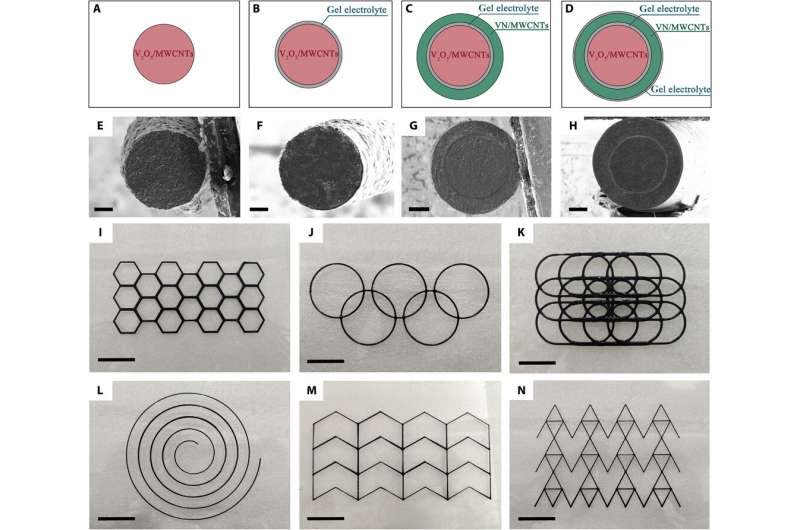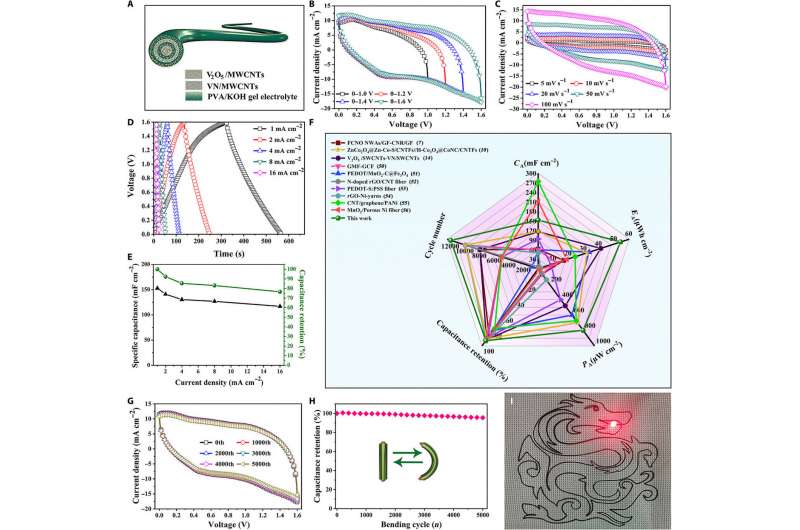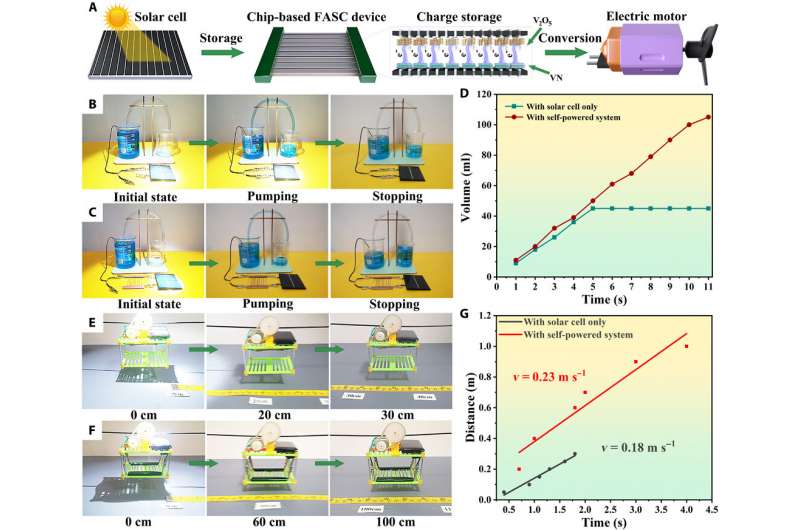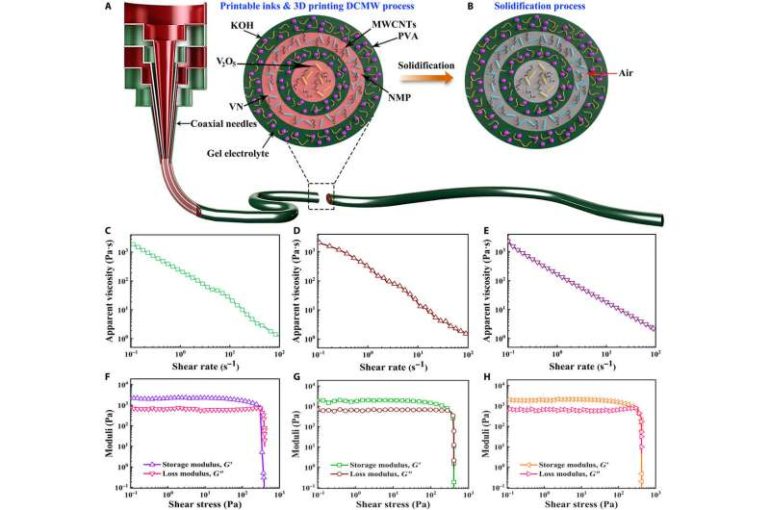Fiber-shaped supercapacitors are a desirable high-performance energy storage technology for wearable electronics. The traditional method for device fabrication is based on a multistep approach to construct energy devices, which can present challenges during fabrication, scalability and durability. To overcome these restrictions, Jingxin Zhao and a team of scientists in physics, electrochemical energy, nanoscience, materials, and chemical engineering in China, the U.S., and Singapore, developed an all-in-one coaxial fiber-shaped asymmetric supercapacitor (FASC) device. The team used direct coherent multi-ink writing, three-dimensional (3-D) printing technology by designing the internal structure of the coaxial needles and regulating the rheological property and feed rates of the multi-ink. The device delivered a superior areal energy and power density with outstanding mechanical stability. The team integrated the fiber-shaped asymmetric supercapacitor (FASC) with mechanical units and pressure sensors to realize high performance and self-powered mechanical devices to monitor systems. The work is now published on Science Advances.
Texture-based wearable electronics
Advances in textile-based wearable electronics can be achieved with advanced fibrous energy storage devices with excellent knittability, flexibility and high mechanical stability. Fiber-shaped asymmetric supercapacitors (FASCs) are widely in use to develop wearable electronics as a promising fiber-shaped energy storage device due to their high power density, long cycling stability, excellent reversibility and improved energy density. In this work, Zhou et al. integrated high-throughput 3-D printing direct ink-writing technology to construct the all-in-one coaxial FASC device with compact internal structures. For this, they rationally designed the device using 3-D printed direct, coherent multi-ink writing (DCMW). The team also designed the internal structure of the multicore-shell needles by charge matching different electrodes, where the rheological properties of the multi-inks matched each other from the innermost layer to the outermost layer during 3-D printing.
The device contained a compact four-layer structure that shortened the ion diffusion path to improve the electrochemical performance and mechanical durability of the device under bending. The team produced a proof-of-concept FASC device with vanadium oxide nanowires/multiwalled carbon nanotubes (MWCNTs) and vanadium nitride (VN) nanowires with multiwalled carbon nanotubes, as positive and negative electrodes, respectively. The performance of the construct surpassed the existing 3-D printing supercapacitor devices to offer a universal strategy to form on-demand fibrous energy storage devices within wearable electronics.
The Fabrication process
The researchers next synthesized the positive and negative electrodes to build the high-energy density FASC device. Thereafter, they uncovered the microstructure and morphology of the samples using field-emission scanning electron microscopy (FESEM) and transmission electron microscopy (TEM). They then used X-ray photoelectron spectroscopy (XPS) to survey the surface elements of the prepared samples. The team used as-printed coherent multi-inks and polyvinyl alcohol (PVA) with good rheological behavior as the 3-D printable inks to achieve the coaxial FASC device. They tuned the composition and rheology behavior of the inks for successful extrusion to maintain a self-supporting pattern. The team explained the ink behaviors with the Herschel-Bulckley model, where the values of viscosity were suitable for printing.

Materials characterization and electrochemical flexible performance of the device
The team characterized the cross-sections of scanning electron microscopy (SEM) images of the different variants of positive and negative electrodes developed in the lab. They confirmed the phase composition and chemical states of the material ink by using X-ray powder diffraction, X-ray photoelectron spectroscopy and Raman spectra. The team observed the cross-sectional SEM image of the 3-D printing coaxial FASC device and also printed a variety of complicated patterns by 3-D printing DCMW technology to demonstrate the competence of the setup to form 3-D printed coaxial FASC devices with high accuracy and scalability. The stress-strain performance results showed excellent flexibility and mechanical strength of the printed fiber-electrodes and devices. The team observed the mesopore structures of the positive and negative electrode fibers on the basis of the pore size distribution, which benefitted the transport and diffusion of electrolyte ions during the fast charge/discharge process.

Integrating the 3-D printing coaxial FASC device within a wearable device.
In order to realize the high energy density 3-D printing coaxial FASC device for a wearable device, Zhou et al. selected the accurate electrochemical performances of the positive and negative electrodes via charge matching. The as-printed coaxial FASC device embraced outstanding electrochemical performance and showed a high working voltage of 1.6 V. The team assessed the electrochemical performance of the fabricated 3-D printing coaxial device using galvanostatic charge/discharge (GCD) and electrochemical impedance spectroscopy (EIS). The results revealed the desired capacitive behavior for the as-prepared FASC device. The specific capacitance of the whole device surpassed most of the conventional fiber-shaped supercapacitors. To demonstrate the feasibility of powering the electronic devices, Zhou et al developed a fully charged 3-D printing coaxial FASC device in the shape of a dragon to illuminate a 1.5 V red light-emitting diode (LED).

Constructing a self-powered and self-moving system for energy storage and conversion
The scientists then integrated the FASC devices with a solar cell and electric motor to realize a self-powered system to convert solar energy into electric energy and mechanical energy. The as-fabricated 3-D printing coaxial FASC device provided power to the pressure sensor in the setup based on bioinspired multiscale structured polydimethylsiloxane (PDMS) and polypyrolle stamps due to the existence of the multiscale architecture. The team did not observe performance degradation after 600 loading/unloading cycles to demonstrate the excellent cycle stability of the device. The all-in-one coaxial solid-state FASC device with high energy density therefore proved a prospective candidate across the new fields of artificial intelligence, robotics and sensing.
In this way, Jingxin Zhao and colleagues developed a 3-D printing direct coherent multi-ink writing technology to fabricate an all-in-one coaxial solid-state FASC device with an ultrahigh areal energy or power density, with multi-inks. The compact structure of the printed coaxial FASC device embraced splendid flexibility and mechanical stability performance that was superior to traditional architecture asymmetric supercapacitors. The 3-D printing coaxial FASC devices served as on-demand energy storage units to drive pinwheels, pumping prototypes, electric cars, and pressure sensors with improved performance. The results offer a highly versatile solution to design high-performance, on-demand, fiber-based energy storage devices for advanced wearable applications.
New electrode configuration improves volumetric performance of supercapacitors
More information:
Zhao J. et al. Direct coherent multi-ink printing of fabric supercapacitors, Science Advances, DOI: 10.1126/sciadv.abd6978
Shi P. et al. Design of amorphous manganese oxide@multiwalled carbon nanotube fiber for robust solid-state supercapacitor, ACS Nano, doi.org/10.1021/acsnano.6b06357
Lee A. et al. 3-D bioprinting of collagen to rebuild components of the human heart. Science, DOI: 10.1126/science.aav9051
2021 Science X Network
Citation:
Direct coherent multi-ink printing of fabric supercapacitors (2021, January 29)
retrieved 30 January 2021
from https://phys.org/news/2021-01-coherent-multi-ink-fabric-supercapacitors.html
This document is subject to copyright. Apart from any fair dealing for the purpose of private study or research, no
part may be reproduced without the written permission. The content is provided for information purposes only.



